*/
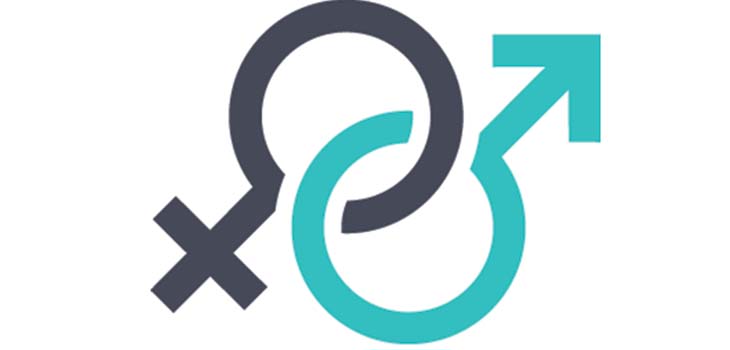
This article, with the help of a unique dataset on litigation before the House of Lords and Supreme Court from 1970-2020, looks at the extent of progress in fair access to work and significance of seniority and specialisation in litigation before our highest court.
We know that women are significantly underrepresented at the top of the legal profession and especially among barristers practising appellate litigation. A number of reasons have been offered for this, including the proportion of women barristers who are primary carers of children (57% compared to 4% of men: Barristers’ Working Lives 2013) and that the way barristers’ work is organised is not sufficiently supportive of primary carers. According to Barristers’ Working Lives 2021, 43% of female barristers have experienced bullying, harassment and discrimination: 43% compared with 17% of male barristers. Further, recent earnings data published by the Bar Standards Board in February 2022 shows female barristers to be earning less than male barristers within the same area of law and similar levels of seniority,and those from minority ethnic backgrounds likely to earn the least. It has also been suggested that women counsel, and especially self-employed female juniors, are not being given the same valuable professional opportunities as male counsel in comparable situations. All these factors will impact retention rates.
Being briefed to appear before the Supreme Court is a visible and significant mark of professional recognition for an advocate and important for social legitmacy of the law. It is almost a rite of passage for future members of the senior judiciary: 72% of current Court of Appeal judges appeared before the UK’s highest court at least once; 41% of the court’s judges did so three times or more (data from December 2020). Baroness Hale in her 2019 Denning Lecture, spoke of ‘women not being instructed in the best cases’ and that ‘[w]e certainly don’t see as many women appearing in the Supreme Court as we ought to do’.
Studies by Hanretty and Vaughan (‘Patronising Lawyers? Homophily and Same-Sex Litigation Teams before the UK Supreme Court’ [2017] Public Law, 426) and The Lawyer (B. Veyrat, A. Mehta and C. Griffiths, ‘The Long Read: How Gendered Instructions at the Employment Bar Are Scuppering Female Barristers’, July 2019) showed this to be the case by at least two measures: (1) lower proportions of both senior and junior female counsel in the studied kinds of appellate litigation (compared to proportions of senior and junior women in the self-employed Bar) and (2) lower likelihood that a male senior counsel will have a junior female on his team than a junior man.
As I show here, based on my own dataset, there are reasons to think that the situation is improving and may be better than we thought for some classes of counsel (ie the junior junior). My research continues the path pioneered by Hanretty and Vaughan in their study of team formation among barristers who appeared before the Supreme Court between October 2009 and August 2015. I have also benefited from the insightful coverage of gender at the Bar by HHJ Emma Nott in Counsel magazine.
Assembling a dataset covering the years 1970 to 2020 has allowed me to study broader trends, but I am also limited by the data I could access and process with the custom software I wrote for the purposes of this project. Notably, I did not have individual data on ethnic and socio-economic backgrounds of barristers.
My dataset covers all counsel who appeared before the House of Lords and the Supreme Court since 1970. This comprises 5,041 counsel: 3,868 (76.7%) of whom I classified as male and 880 as female (17.5%). The method of identification was to identify the barrister listed first as leader of the case team and all other members as juniors. Given that the dataset spans 50 years, the total numbers are not very meaningful. Instead, we can focus on the trends as illustrated in Figure 1. In the 1970s, almost no women counsel appeared before the House of Lords. In 2017, women made up 27% of appearances before the Supreme Court (25% in 2020). For reference, women constitute around 36% of self-employed practising barristers.
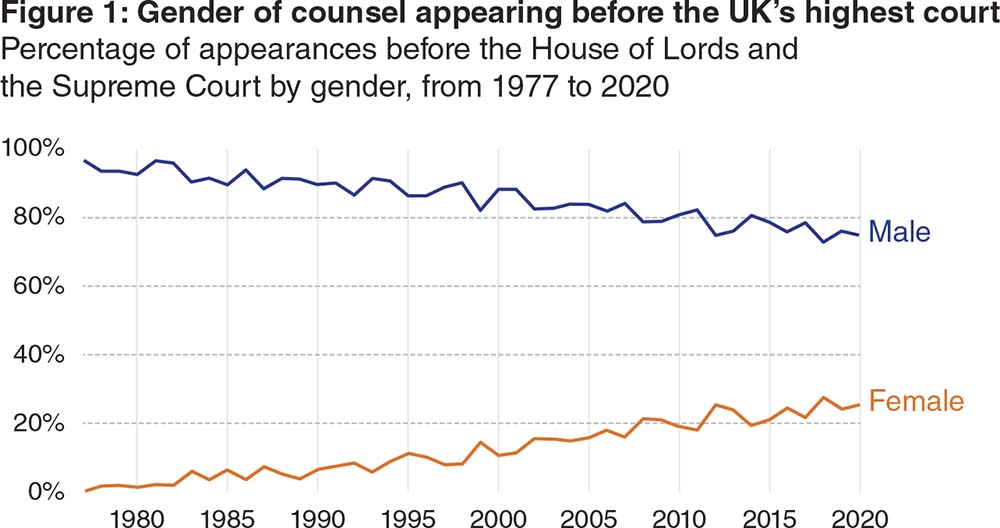
Figure 2 shows that even though women are now appearing as leaders in a higher proportion of cases than in the 1980s, it is unclear whether there has been any progress in this respect since the late 2000s.
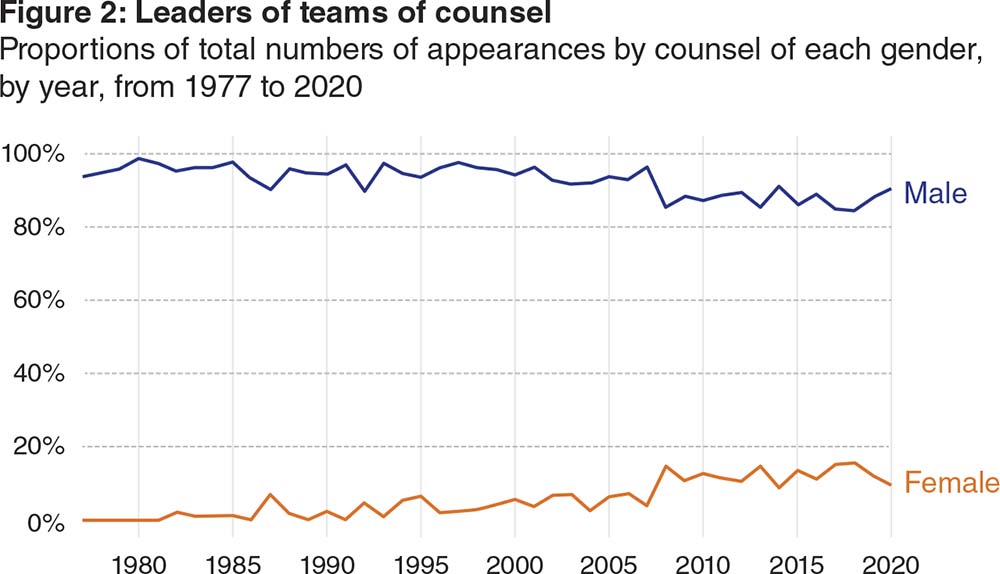
The story is more promising for female juniors. In Figure 3 we can see a clear rising trend that is approaching the total proportion of women at the self-employed Bar.
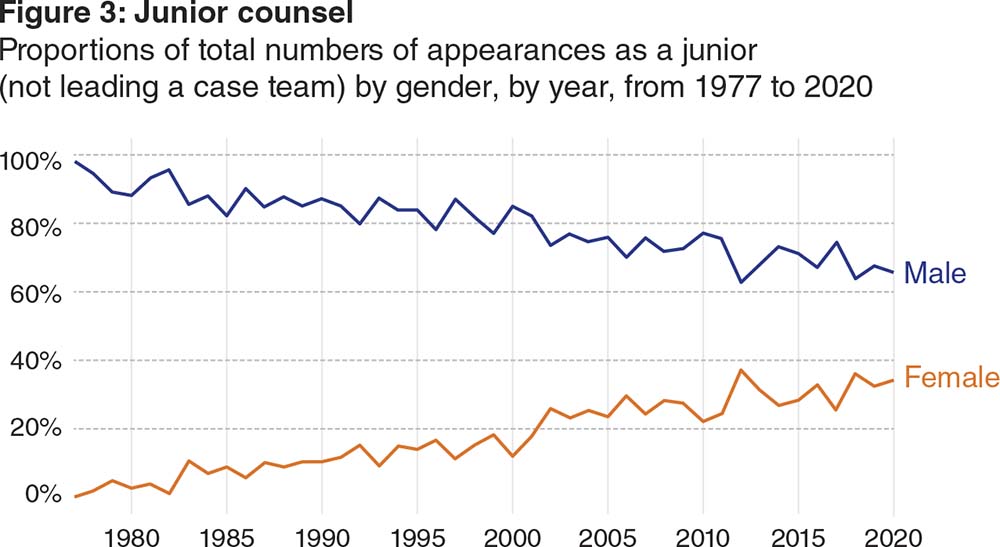
And if we look at appearances relative to the year a person joined the Bar, this leads to a striking observation: in the 2010s, women constituted 47.3% of barristers who had their first appearance before the Supreme Court before their fifth year of call (see Table 1). This is higher than the proportion of women among all self-employed barristers under five years’ call. Note that the absolute numbers of male barristers who had their first appearance before fifth year post call have been steady over the whole dataset timespan.
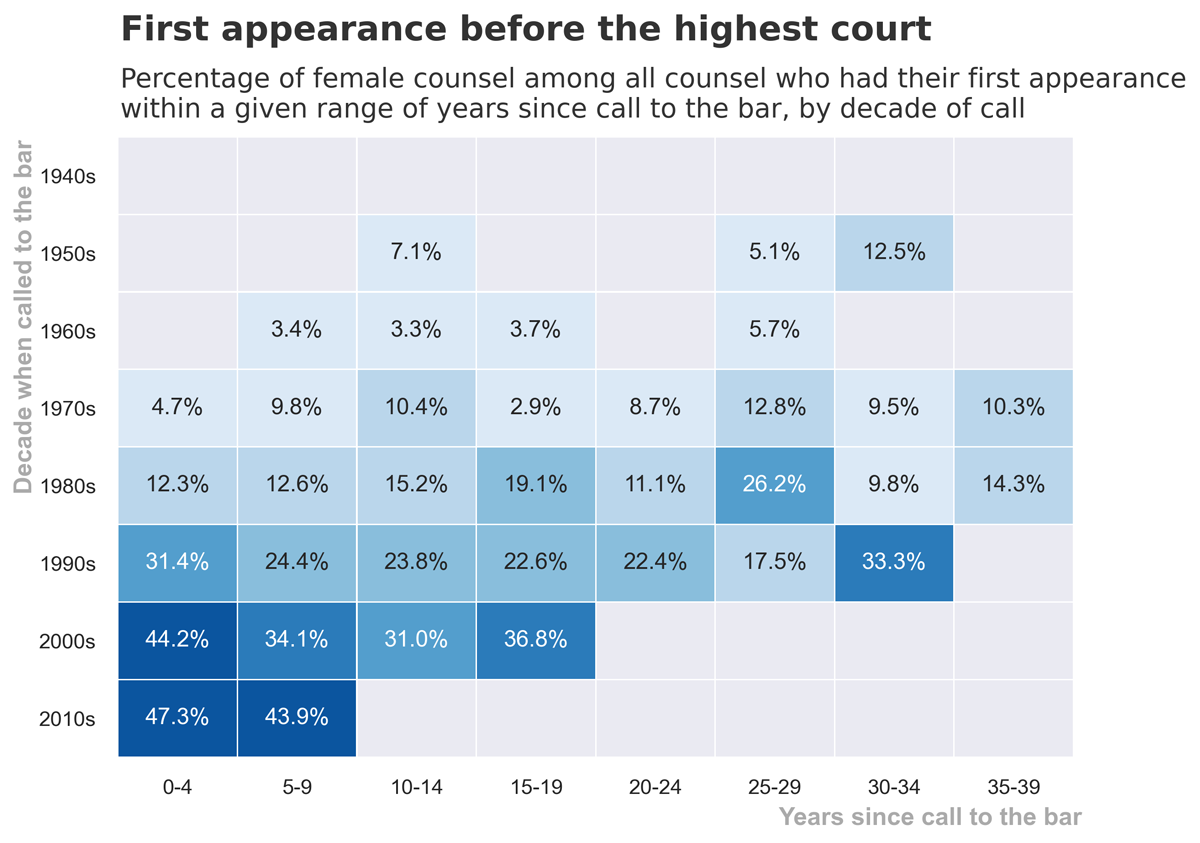
In 2017, Vaughan and Hanretty noticed that teams of lawyers before the Supreme Court are characterised by ‘homophily’, ie teams are relatively less likely to be mixed-gender. I found that this phenomenon has been clearly declining:
From almost all same-sex case teams (ie all-male) in the 1970s, this ratio has fallen to 0.55 in 2019 and 0.48 in 2020. The blue and red lines in Figure 4 are so close (and overlap until around 1980) because the vast majority of case teams are male-led. There is a lower proportion of women leaders who have female-only teams than that of male leaders who have male-only teams.
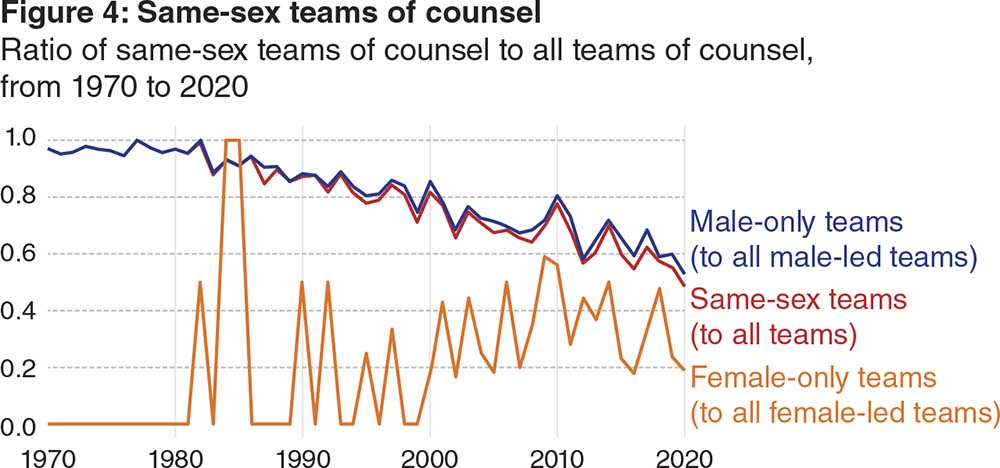
Today, there is a clear rising trend for male leaders: there is a much higher proportion of male-led teams including women than at any time in the past. However, we are not yet at a point where men lead as many teams that include women and teams that don’t include women (ie a ratio of 1). It is harder to interpret the data on female leaders (see Figure 5). First, the absolute numbers of case teams led by women are low (eg four between 1980 and 1984). The absolute numbers of women-led case teams become more meaningful from 2005 onwards – in this period women led a higher proportion of teams with at least one female junior. Interestingly, this proportion seems to have fallen for 2015-19. I don’t have a good answer why.
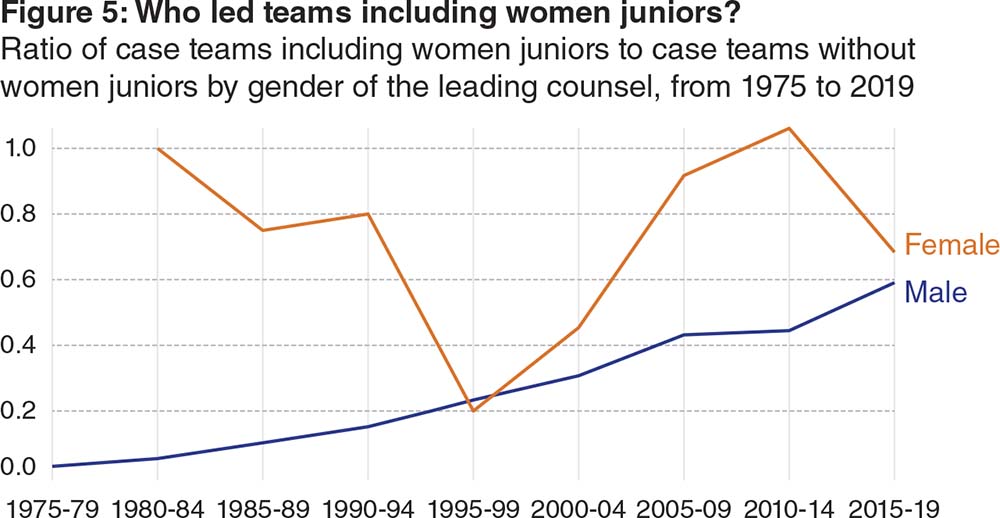
Just because women leaders have a higher proportion of case teams including women juniors, it does not follow that women leaders are (or should be) chiefly responsible for ‘bringing’ junior women counsel to the highest court. The absolute numbers of female juniors led by female leaders are small compared to the numbers of female juniors led by male leaders, as illustrated in Figure 6.
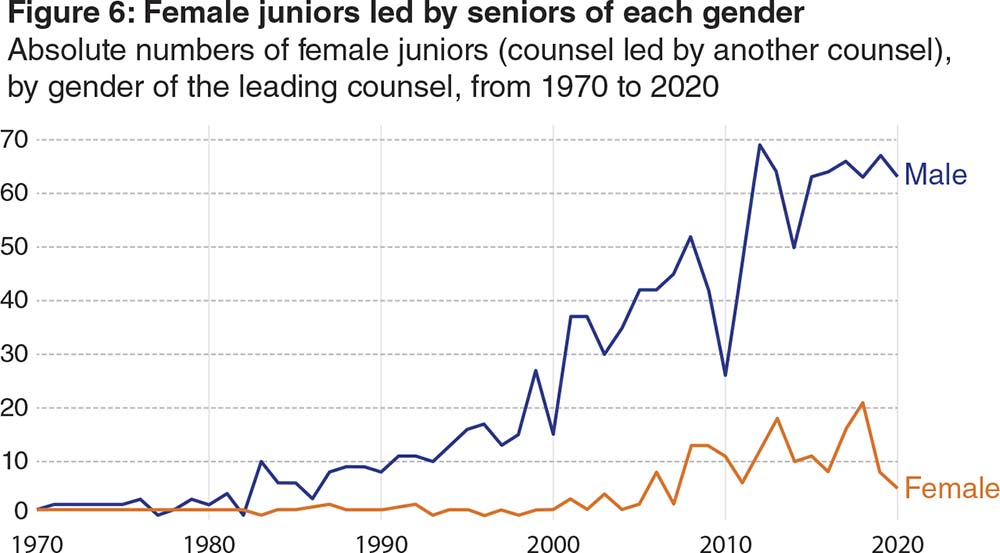
As one might expect based on anecdotal information, there are significant differences in gender appearance rates by area of law. Figure 7 illustrates appearances by women counsel for five-year periods from 1991 to 2020 with appearances in civil/commercial law – the most lucrative practice areas of the Bar – at the lowest end.
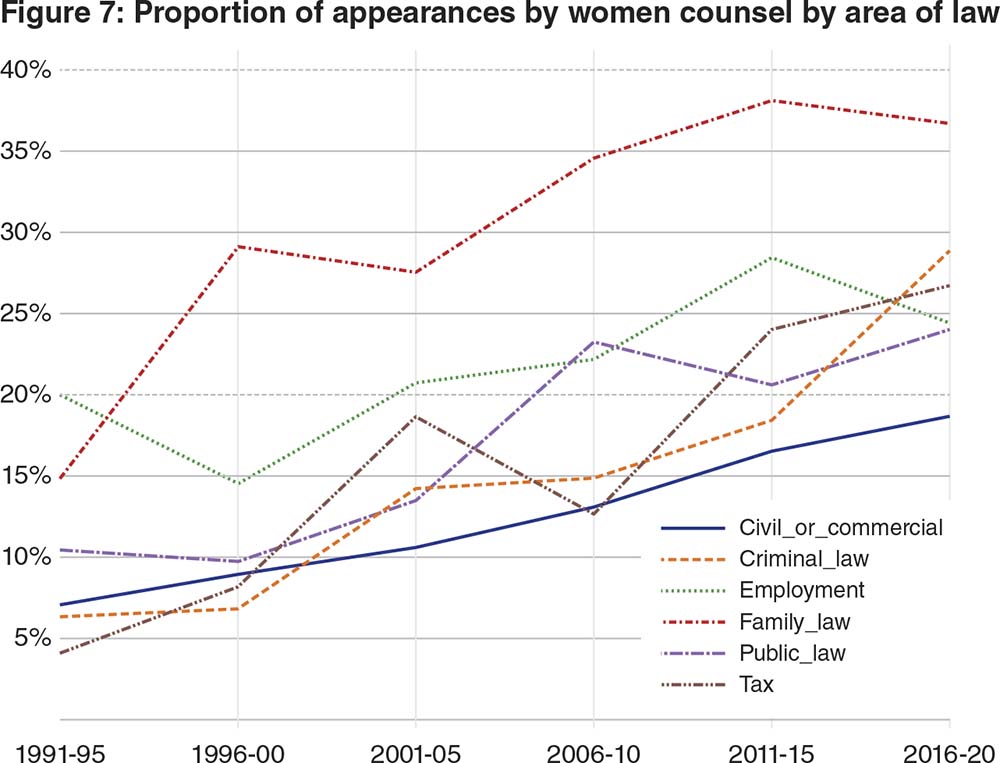
The Supreme Court Bar is, in a sense, a specialist Bar dominated by experienced counsel who appear before the court repeatedly. Table 2 shows the barristers with the highest numbers of appearances before the Supreme Court in the last 10 years. They also show the percentages of appearances by women juniors in case teams led by each counsel.
In the 2010s, the top 10% of counsel (by number of appearances) appeared in 77.6% of Supreme Court cases. Women constituted 21.9% of the top 10% of counsel. The average number of years’ call for a barrister’s first Supreme Court case was 17.9; 75% of all counsel in 2010s were more than 10 years’ call. Hence, there is a real risk that unless the proportion of women among junior barristers carries through to the more senior end of the profession, the overall picture of the Supreme Court Bar will not change much.
There is one job, so far held only by men, which has played a very prominent role at the Supreme Court, at least since the mid-2000s. Appointing a woman as the next First Treasury Counsel would likely contribute to the prevalence of female advocates in the Supreme Court. I found that the hypothetical ‘switching’ of Sir James Eadie QC’s (current First Treasury Counsel) gender for 2019 would have increased the proportion of case appearances by women counsel in that year by 2%. However, given that female senior counsel lead case teams including women juniors at a higher rate than male senior counsel, and the number of Supreme Court cases in which First Treasury Counsel appear, having a female ‘Treasury Devil’ could have a more significant ‘trickle-down’ effect on the ratio of women juniors in the Supreme Court.

So, the million-dollar question – will the ratio of women among senior counsel at the Supreme Court improve appreciably and soon? There are three reasons to think that it could:
These are not reasons for complacency. Considering the very real problem of attrition of women within the profession, the next question is whether the Bar can keep hold of them. The data suggests that we will not see a large increase in the overall proportion of women in the Supreme Court Bar (and certainly at the top of that) unless women counsel from the new ‘high wave’ stay in the profession for at least ten more years.

This article, with the help of a unique dataset on litigation before the House of Lords and Supreme Court from 1970-2020, looks at the extent of progress in fair access to work and significance of seniority and specialisation in litigation before our highest court.
We know that women are significantly underrepresented at the top of the legal profession and especially among barristers practising appellate litigation. A number of reasons have been offered for this, including the proportion of women barristers who are primary carers of children (57% compared to 4% of men: Barristers’ Working Lives 2013) and that the way barristers’ work is organised is not sufficiently supportive of primary carers. According to Barristers’ Working Lives 2021, 43% of female barristers have experienced bullying, harassment and discrimination: 43% compared with 17% of male barristers. Further, recent earnings data published by the Bar Standards Board in February 2022 shows female barristers to be earning less than male barristers within the same area of law and similar levels of seniority,and those from minority ethnic backgrounds likely to earn the least. It has also been suggested that women counsel, and especially self-employed female juniors, are not being given the same valuable professional opportunities as male counsel in comparable situations. All these factors will impact retention rates.
Being briefed to appear before the Supreme Court is a visible and significant mark of professional recognition for an advocate and important for social legitmacy of the law. It is almost a rite of passage for future members of the senior judiciary: 72% of current Court of Appeal judges appeared before the UK’s highest court at least once; 41% of the court’s judges did so three times or more (data from December 2020). Baroness Hale in her 2019 Denning Lecture, spoke of ‘women not being instructed in the best cases’ and that ‘[w]e certainly don’t see as many women appearing in the Supreme Court as we ought to do’.
Studies by Hanretty and Vaughan (‘Patronising Lawyers? Homophily and Same-Sex Litigation Teams before the UK Supreme Court’ [2017] Public Law, 426) and The Lawyer (B. Veyrat, A. Mehta and C. Griffiths, ‘The Long Read: How Gendered Instructions at the Employment Bar Are Scuppering Female Barristers’, July 2019) showed this to be the case by at least two measures: (1) lower proportions of both senior and junior female counsel in the studied kinds of appellate litigation (compared to proportions of senior and junior women in the self-employed Bar) and (2) lower likelihood that a male senior counsel will have a junior female on his team than a junior man.
As I show here, based on my own dataset, there are reasons to think that the situation is improving and may be better than we thought for some classes of counsel (ie the junior junior). My research continues the path pioneered by Hanretty and Vaughan in their study of team formation among barristers who appeared before the Supreme Court between October 2009 and August 2015. I have also benefited from the insightful coverage of gender at the Bar by HHJ Emma Nott in Counsel magazine.
Assembling a dataset covering the years 1970 to 2020 has allowed me to study broader trends, but I am also limited by the data I could access and process with the custom software I wrote for the purposes of this project. Notably, I did not have individual data on ethnic and socio-economic backgrounds of barristers.
My dataset covers all counsel who appeared before the House of Lords and the Supreme Court since 1970. This comprises 5,041 counsel: 3,868 (76.7%) of whom I classified as male and 880 as female (17.5%). The method of identification was to identify the barrister listed first as leader of the case team and all other members as juniors. Given that the dataset spans 50 years, the total numbers are not very meaningful. Instead, we can focus on the trends as illustrated in Figure 1. In the 1970s, almost no women counsel appeared before the House of Lords. In 2017, women made up 27% of appearances before the Supreme Court (25% in 2020). For reference, women constitute around 36% of self-employed practising barristers.

Figure 2 shows that even though women are now appearing as leaders in a higher proportion of cases than in the 1980s, it is unclear whether there has been any progress in this respect since the late 2000s.

The story is more promising for female juniors. In Figure 3 we can see a clear rising trend that is approaching the total proportion of women at the self-employed Bar.

And if we look at appearances relative to the year a person joined the Bar, this leads to a striking observation: in the 2010s, women constituted 47.3% of barristers who had their first appearance before the Supreme Court before their fifth year of call (see Table 1). This is higher than the proportion of women among all self-employed barristers under five years’ call. Note that the absolute numbers of male barristers who had their first appearance before fifth year post call have been steady over the whole dataset timespan.

In 2017, Vaughan and Hanretty noticed that teams of lawyers before the Supreme Court are characterised by ‘homophily’, ie teams are relatively less likely to be mixed-gender. I found that this phenomenon has been clearly declining:
From almost all same-sex case teams (ie all-male) in the 1970s, this ratio has fallen to 0.55 in 2019 and 0.48 in 2020. The blue and red lines in Figure 4 are so close (and overlap until around 1980) because the vast majority of case teams are male-led. There is a lower proportion of women leaders who have female-only teams than that of male leaders who have male-only teams.

Today, there is a clear rising trend for male leaders: there is a much higher proportion of male-led teams including women than at any time in the past. However, we are not yet at a point where men lead as many teams that include women and teams that don’t include women (ie a ratio of 1). It is harder to interpret the data on female leaders (see Figure 5). First, the absolute numbers of case teams led by women are low (eg four between 1980 and 1984). The absolute numbers of women-led case teams become more meaningful from 2005 onwards – in this period women led a higher proportion of teams with at least one female junior. Interestingly, this proportion seems to have fallen for 2015-19. I don’t have a good answer why.

Just because women leaders have a higher proportion of case teams including women juniors, it does not follow that women leaders are (or should be) chiefly responsible for ‘bringing’ junior women counsel to the highest court. The absolute numbers of female juniors led by female leaders are small compared to the numbers of female juniors led by male leaders, as illustrated in Figure 6.

As one might expect based on anecdotal information, there are significant differences in gender appearance rates by area of law. Figure 7 illustrates appearances by women counsel for five-year periods from 1991 to 2020 with appearances in civil/commercial law – the most lucrative practice areas of the Bar – at the lowest end.

The Supreme Court Bar is, in a sense, a specialist Bar dominated by experienced counsel who appear before the court repeatedly. Table 2 shows the barristers with the highest numbers of appearances before the Supreme Court in the last 10 years. They also show the percentages of appearances by women juniors in case teams led by each counsel.
In the 2010s, the top 10% of counsel (by number of appearances) appeared in 77.6% of Supreme Court cases. Women constituted 21.9% of the top 10% of counsel. The average number of years’ call for a barrister’s first Supreme Court case was 17.9; 75% of all counsel in 2010s were more than 10 years’ call. Hence, there is a real risk that unless the proportion of women among junior barristers carries through to the more senior end of the profession, the overall picture of the Supreme Court Bar will not change much.
There is one job, so far held only by men, which has played a very prominent role at the Supreme Court, at least since the mid-2000s. Appointing a woman as the next First Treasury Counsel would likely contribute to the prevalence of female advocates in the Supreme Court. I found that the hypothetical ‘switching’ of Sir James Eadie QC’s (current First Treasury Counsel) gender for 2019 would have increased the proportion of case appearances by women counsel in that year by 2%. However, given that female senior counsel lead case teams including women juniors at a higher rate than male senior counsel, and the number of Supreme Court cases in which First Treasury Counsel appear, having a female ‘Treasury Devil’ could have a more significant ‘trickle-down’ effect on the ratio of women juniors in the Supreme Court.

So, the million-dollar question – will the ratio of women among senior counsel at the Supreme Court improve appreciably and soon? There are three reasons to think that it could:
These are not reasons for complacency. Considering the very real problem of attrition of women within the profession, the next question is whether the Bar can keep hold of them. The data suggests that we will not see a large increase in the overall proportion of women in the Supreme Court Bar (and certainly at the top of that) unless women counsel from the new ‘high wave’ stay in the profession for at least ten more years.


Chair of the Bar reflects on 2025
AlphaBiolabs has donated £500 to The Christie Charity through its Giving Back initiative, helping to support cancer care, treatment and research across Greater Manchester, Cheshire and further afield
Q&A with criminal barrister Nick Murphy, who moved to New Park Court Chambers on the North Eastern Circuit in search of a better work-life balance
Revolt Cycling in Holborn, London’s first sustainable fitness studio, invites barristers to join the revolution – turning pedal power into clean energy
Rachel Davenport, Co-founder and Director at AlphaBiolabs, reflects on how the company’s Giving Back ethos continues to make a difference to communities across the UK
By Marie Law, Director of Toxicology at AlphaBiolabs
Are you ready for the new way to do tax returns? David Southern KC explains the biggest change since HMRC launched self-assessment more than 30 years ago... and its impact on the Bar
Professor Dominic Regan and Seán Jones KC present their best buys for this holiday season
Marking one year since a Bar disciplinary tribunal dismissed all charges against her, Dr Charlotte Proudman discusses the experience, her formative years and next steps. Interview by Anthony Inglese CB
Little has changed since Burns v Burns . Cohabiting couples deserve better than to be left on the blasted heath with the existing witch’s brew for another four decades, argues Christopher Stirling
Pointillism, radical politics and social conscience. Review by Stephen Cragg KC